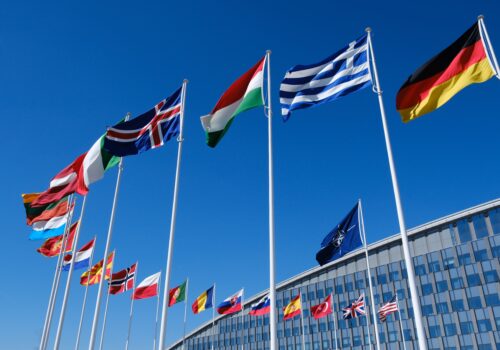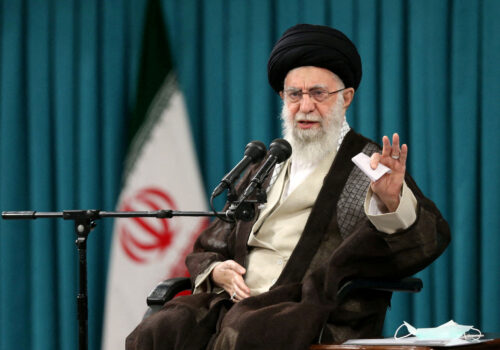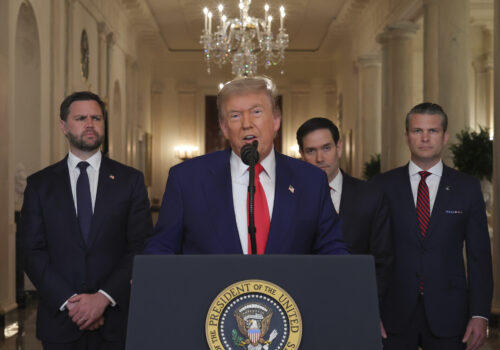Dispatch from The Hague: How Trump can build on his Middle East success with NATO
THE HAGUE—There’s both bad news and far better news from Iran for NATO leaders gathering here today and tomorrow for their Alliance’s long-planned summit.
The bad news is that the Trump administration’s strikes on Iran’s nuclear facilities have shifted attention from Russia’s war on Ukraine. While US President Donald Trump has shrugged off Russian President Vladimir Putin’s bald rejection of his peace efforts over the war in Ukraine, Russia has escalated its bombing and killing of innocent Ukrainian civilians. Trump has shown Putin nothing like the impatience he’s demonstrated with Iranian leaders over their negotiating delay.
The far better news is that Trump has rediscovered in Iran the power of deterrence. For years, Tehran built up its nuclear weapons potential, supported proxies that threaten its neighbors, and backed terrorists who killed Americans and others. It became by far the Middle East’s most disruptive actor. But by choosing to demonstrate strength, Trump has rolled back the Iranian regime’s gains and created the conditions for a possible cease-fire between Iran and Israel.
The power of US pressure
In making this successful choice, Trump acted against the opposition of those in his administration who mistakenly see in every intervention the danger of an Iraq-like quagmire and wasted American resources. These same advisers who oppose a muscular response to Iran also often stand against tougher actions to counter Putin. Trump has wisely rebutted these so-called restrainers and neo-isolationists on Iran, and he should now do so regarding Russia as well.
Writes the Atlantic Council’s John Herbst: “The devastating US blow to Iran’s nuclear program makes clear that Trump understands the need for strong action when American interests are on the line. He has now acted on that understanding in the Middle East. The same could and should apply in eastern Europe. This does not require US military action—just increasing economic pressure on Russia and sending military supplies to Ukraine. In Trump world, opponents of that sound policy are now weaker.”
Putin is also looking weaker in the face of Trump’s strength. “Russia has done nothing beyond offer words to defend its ally Iran,” Herbst writes. “If the United States starts to exert the pressure on Russia that Trump has promised for Putin’s blocking of peace, he would take a large step toward halting Russia’s aggression in Ukraine.”
A ‘quantum leap’
The Hague summit has been designed to be a Trump victory—and to reinforce allied cohesiveness as well. Reflecting an overriding US goal, one that will likely consume the post-summit communiqué, almost all of NATO’s thirty-two members are set to agree to spend 5 percent of their gross domestic product (GDP) on defense. This will be made up of 3.5 percent of GDP on core defense and 1.5 percent of GDP on defense-related expenditures. The deadline by which allies must achieve these amounts is a negotiating point, but discussions are zeroing in on some time between 2030 and 2035.
The vastly increased NATO spending goals are “a quantum leap that is ambitious, historic, and fundamental to securing our future,” said NATO Secretary General Mark Rutte, who is hosting the summit in his native Netherlands. He added that the investment plan includes a fivefold increase in NATO’s air defense capabilities, thousands of armored vehicles, and millions of rounds of ammunition and artillery.
All other public summit goals this week will be subservient to the 5 percent goal, which allies hope will also assuage any who continue to wonder about the United States’ commitment to the Alliance and its participation in NATO defense guarantees. The leaders’ total time together in working sessions has been reduced to two-and-a-half hours on Wednesday, in an effort to apply allied discipline to the extent possible with Trump. Everything has been choreographed to focus Trump’s time with follow leaders and to avoid the sort of typical multilateral setting, with its many speeches and position statements, that he abhors.
A way to confound European critics
There’s a chance that the Trump visit could be a victory lap.
He can already justifiably trumpet three generational achievements in the Middle East: destroying Iran’s nuclear sites, restoring US deterrence, and opening the way for a larger realignment of the Middle East following an Iran-Israel cease-fire. In time, this realignment could create security and defense integration, built upon the Abraham Accords, among Israel and politically moderate, religiously tolerant, and economically modernizing states in the region.
He then may be able to add to this success story if NATO delivers a more galvanized European defense grouping within NATO, one that will provide greater defense spending, produce more robust capabilities, and do it all in time to save Ukraine, contain Russia, and stabilize Europe. Ukraine will not be the main issue at this summit, but this broader defense-spending effort could be more transformative for Kyiv—and damaging to Putin—than any strongly worded communiqué.
Much can go wrong at any multilateral summit Trump attends, often by his design. This week, however, Trump has it within his grasp to bring his Middle East success story to Europe and apply its deterrence lessons to Putin, though through different means. He could confound European critics by sounding his support for NATO, thanking those European leaders who are stepping up their defense spending, and then returning home with both a safer Middle East and a sounder transatlantic Alliance.
Frederick Kempe is president and chief executive officer of the Atlantic Council. You can follow him on X: @FredKempe.
This edition is part of Frederick Kempe’s Inflection Points newsletter, a column of dispatches from a world in transition. To receive this newsletter throughout the week, sign up here.
Further reading
Sun, Jun 22, 2025
Trump made the right call. Will Khamenei do the same?
New Atlanticist By William F. Wechsler
The Iranian regime is in a fundamentally weak position, and it should leap at this last opportunity to save itself.
Sat, Jun 14, 2025
Israel’s Iran strike provides a historic chance for Middle East realignment
Inflection Points By Frederick Kempe
History will remember this moment less for the Israeli strikes themselves and more for what follows.
Sat, Jun 21, 2025
Experts react: The United States just bombed Iran’s nuclear sites. Here’s what to expect next.
New Atlanticist By
Early on Sunday morning in the Middle East, US forces targeted Fordow, Natanz, and Isfahan. Atlantic Council experts survey the fallout for Iran and for the region.
Image: US President Donald Trump speaks to media ahead of boarding Marine One to depart to attend the NATO Summit in The Hague, Netherlands, from the South Lawn at the White House in Washington, D.C., U.S., June 24, 2025. REUTERS/Kevin Lamarque




